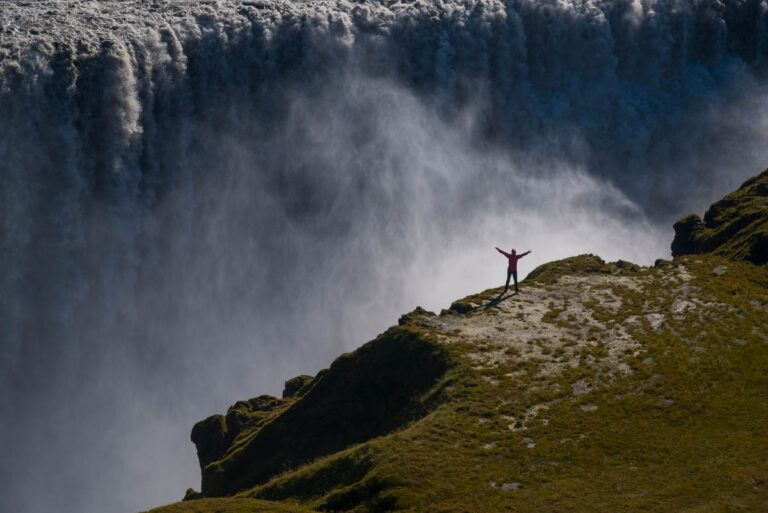Your Complete Guide to Ásbýrgi Canyon
- North Iceland
- 10 Jun 2024

All you need to know about the formation and mythology behind this natural wonder located in North Iceland
Introduction to Ásbýrgi Canyon
Ásbýrgi is a stunning canyon located in Northern Iceland, and is frequently included in itineraries of the so called Diamond Circle tourist route, the northern equivilent of the famous Golden Circle. Part of Vatnajökull National Park, Ásbýrgi is therefore a protected environment. Renowned for its distinctive horse-shoe shape, it measures upto 1km long, 4 km wide, with its sheer, vertical cliffs reaching uptp 100m in height. It is an impressive sight indeed. The canyon is filled with lush, green woods and a serene lake called Botnstjörn.



Where is Ásbýrgi located and how to get there?
Ásbýrgi is in North Iceland, about 1h 45 mins drive from Akureyri. It can be included as a stop as part of a self-drive Ring Road tour as well.
There are no public buses to Ásbýrgi, so your best options are either driving yourself, or joining a guided day tour from Akureyri or Húsavík. During summer, BusTravel Iceland offers 3 tours that include Ásbýrgi as one of the highlights. See our selection below.
Húsavík is the nearest large town. Taking a taxi from there, while theorectically possible, would be very expensive.
How was Ásbýrgi Canyon formed?
This canyon is renowned for its distinctive horseshoe-shaped depression. This unique geological feature is posited to be the result of immense and sudden glacial floods that are believed to have overwhelmed the area, leading to the canyon’s sharp bends. The glacier river named Jökulsá á fjöllum flooded the landscaped repeatadly and catastrophically between 3000-10,000 years ago. The formation of Ásbýrgi is therfore heavily influenced by its proximity to Vatnajökull, Europe´s largest glacier, which feeds the river in question. This same river also feeds other northern landmarks such as Dettifoss waterfall.
Glacial flooding is most often caused by sub-glacial geothermal heat, which leads to a Jökulhlaup, which translates as glacier run. It is theorized that the glacial flooding that formed Ásbýrgi was caused by the eruption of Grímsvötn volcano.
This is a prime example of the influence of both glaciers and volcanoes, and their interaction, have shaped Iceland.
Ásbýrgi Canyon: Culture & Mythology

As is common across the world, our ancestors used mythology to explain natural phenomena. In a scientifically less-enlightened time, how else to explain the unique geology of Ásbýrgi. Iceland before 1000ad was a pagan country whose people worshipped the norse gods. Even after Christianisation arouns 1000ad, the myths and folklore surrounding this mythology played a big role in story-telling. The story goes that one of the hoofs of Sleipnir, Óðins eight-legged horse, stepped on the land hear causing this horse-shoe shaped impression.
Other tales have it Ásbýrgi is a vast city for the elves or hidden people.
The Flora & Fauna of Ásbýrgi Canyon
Animal and birdlife at Ásbýrgi

The elusive Arctic fox finds sanctuary amidst the dense woodland here. The only land mammal native to Iceland, arctic foxes demonstrate a keen ability to survive in diverse habitats. In winter their pelts turn a snowy white, this camouflage making hunting much easier. In summer this white coast molts revealing a brown pelt.
A variety of bird species add melody to the air with their calls. Look closely, and you might spot Eurasian Wigeon and Northern Fulmars.
The biodiversity on display at Ásbyrgi Canyon is a vibrant display of life prevailing in the often raw and rugged North Icelandic conditions.
The Forest Ecosystem

Within the horseshoe-shaped embrace of Ásbyrgi Canyon, you’re greeted by an impressive forest ecosystem uncommon in Iceland. This is where birch and willow stand tall, intermingled with conifers such as spruce, larch, and pine, creating a green haven for the woodland creatures.
The forest floor, lush and fertile, supports a wide range of undergrowth, offering sustenance and protection to the canyon’s inhabitants.
Nearby Attractions

Ásbýrgi, in addition to other nearby attractions, forms the Diamond Circle Nature trail, a popular circuit for visitors self-driving or on bus tours.
Dettifoss Waterfall
Just a short drive from Ásbyrgi, you’ll find the thunderous Dettifoss, reputed to be Europe’s most powerful waterfall.
Standing at the edge of the falls, you can feel the mist on your skin and the earth trembling underfoot—a testament to nature’s raw power.
Hljóðaklettar Rock Formations
Further along your journey, encounter the mystical Hljóðaklettar.
This series of volcanic rock formations create a natural labyrinth of echoes, hence its name translating to “The Whispering Cliffs.” Roam through the paths and you’ll discover unique basalt columns that are not only a marvel to behold but a favorite among photographers.
Húsavík fishing village
This picture perfect seaside town is famed as the best place in Iceland for whale watching. The cute corrugated iron church sits just opposite the jetty.
Lake Mývatn
Lake Mývatn is renowned for its unique volcanic landscape, diverse birdlife, geothermal activity, and stunning natural beauty, making it a popular destination for nature enthusiasts. The pseudo craters or Skutustadirgigur are a particular highlight.



















